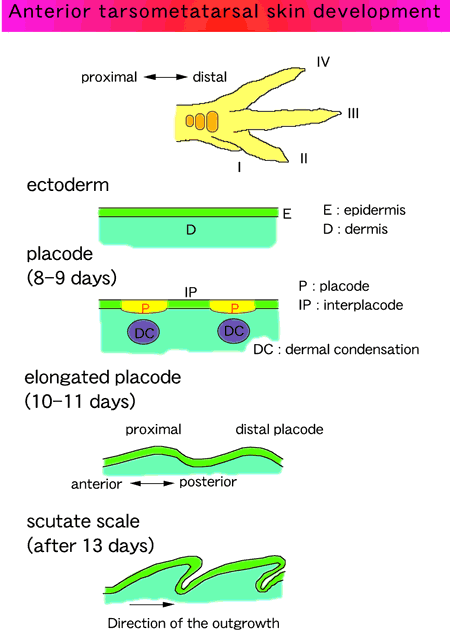
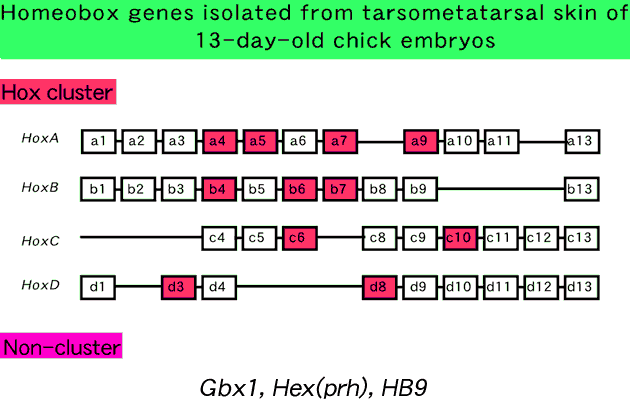
皮膚の分化,形態形成過程におけるホメオボックス遺伝子HB9の発現秋元義弘*、小坂泰弘**、帯刀章子**、平野 寛*
|
| [目的][目的] |
鶏胚脛部皮膚では孵卵9日から鱗形成が開始し,鱗の伸長と並行して15日から17日にかけて角質化がおこる。我々はこの分化,形態形成過程にホメオボックス遺伝子が関与していると考え, degenerate primerを用いて、HB9を含む14個のホメオボックス遺伝子を13日胚脛部皮膚よりクローニングしてきた。HB9は非クラスタータイプのホメオボックス遺伝子であり、リンパ組織や脊髄での発生,分化過程における発現が報告されているが皮膚については報告されていない。今回、この皮膚の分化,形態形成過程におけるホメオボックス遺伝子HB9の発現について調べるために、in situ hybridization法にて検討した。さらにHB9蛋白の発現を免疫組織化学的に検討した。


| [方法][方法] |
In situ hybridization
Immunohistochemistry
| [結果と考察][結果と考察] |
9日胚ではプラコードの表皮基底細胞並びに真皮の細胞にホメオボックス遺伝子HB9の発現が認められた(Fig. 1C)。12〜15日にかけて鱗成長に伴い表側鱗では表皮基底細胞層,表皮中間層にHB9の発現が認められたのに対し,内側鱗では表皮基底層でのみ弱いHB9の発現が認められた(Fig. 1F〜H)。また真皮の細胞にもHB9の発現が認められた。16日以降になると角化の開始に伴ってHB9発現が減少した(Fig. 1I)。さらにHB9蛋白は細胞質並びに核内にPatch状に局在することが観察された(Fig. 2)。内側鱗表皮に比べて表側鱗表皮は細胞増殖が活発であること,さらに16日以降は表皮基底細胞の増殖能が低下することから,HB9は細胞増殖に関与することが推測される。
| [Figures][Figures] |
Fig. 1 Chronological expression of HB9 during anterior tarsometatarsal skin development. Longitudinal section of anterior tarsometatarsal skin from 6.5- to 17-day-old embryos. Direction of outgrowth, anterior-posterior axis is from the left to the right.
B: Basal layer, D: dermis, E: epidermis, In: intermediate layer, Ip: interplacode, Is: inner scale face, K: keratinized layer, LD: lower dermis, Os: outer scale face, P: periderm, PI: placode, Ps: peridermal and subperidermal layers. Bar, 50 μm.




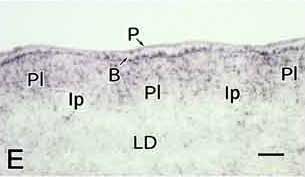
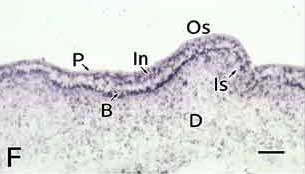
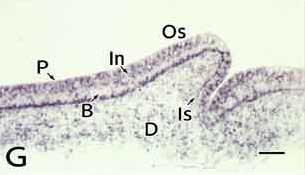
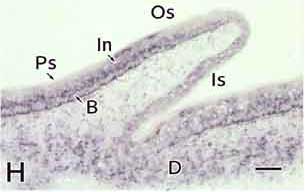
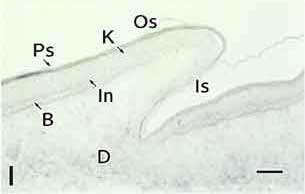

Fig. 2 HB9 protein localization in tarsometatarsal skin. Tarsometatarsal skin at 15 days (stage 41). (A) Epidermis of the outer scale face. HB9 protein is predominant in cytoplasm of the basal and intermediate cells. Speckled signal is also observed in nucleus. (B) Double exposure image. Nucleus is stained by DAPI (blue). Colocalization of Cy3 and DAPI is visualized by overlapping images (purple). This expression pattern is not changed during tarsometatarsal skin development. Bars, 10 μm.
| (本文終り) |